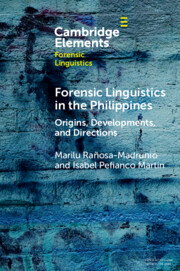Element contents
Forensic Linguistics in the Philippines
Published online by Cambridge University Press: 03 March 2023
Summary
Keywords
- Type
- Element
- Information
- Series: Elements in Forensic LinguisticsOnline ISBN: 9781009106078Publisher: Cambridge University PressPrint publication: 23 March 2023
References
- 11
- Cited by



